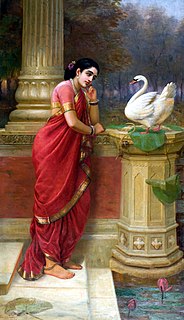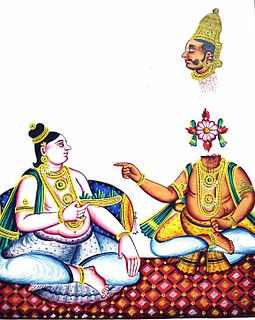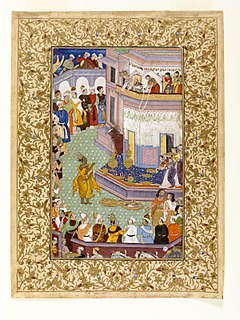
Rukmini or Rukmani is a Hindu goddess and the first queen consort of Krishna, the king of Dwaraka and appeared as avatar of the god Vishnu. She is described as an avatar of Lakshmi.

Damayanti is a character in a love story found in the Vana Parva book of the Mahabharata. She was the daughter of Bhima and a princess of the Vidarbha Kingdom, who married King Nala of the Nishadha Kingdom. The character is also found in other Hindu texts by many authors in numerous Indian languages. She, along with Nala, are the central characters in the 12th century text Nishadha Charita, one of the five mahakavyas in the canon of Sanskrit literature, written by Sriharsha.

Nala, a character in Indian mythology, is the king of Nishadha Kingdom and the son of Veerasena. Nala is known for his skill with horses and for his culinary expertise. He marries princess Damayanti, of the Vidarbha Kingdom, and their story is told in the Mahabharata. His main weakness is gambling. He is possessed by the demon Kali. He was also a great cook and wrote the first-ever book on cookery, Pakadarpanam.
Kekayas or Kaikeyas were an ancient people attested to have been living in north-western Punjab—between Gandhara and the Beas river since remote antiquity. They were the descendants of the Kshatriyas of the Kekaya Janapada hence called Kekayas or Kaikeyas. The Kekayas were often associated with the Madras, the Usinaras, and the Sibis, and their territory had formed a part of the Vahika country, according to the evidence furnished by Pāṇini. The Kingdom of Kekaya was founded by Kekaya who was the son of Shibi in Treta Yuga whose descendant was Kaikeyi.

Kosala Proper or simply Kosala is the kingdom of the celebrated personality of Treta Yuga, Raghava Rama. Ayodhya was its capital, presently in Ayodhya district, Uttar Pradesh. Rama's sons Lava and Kusha inherited parts of this kingdom. Lava ruled from the city called Ayodhya and Kusa from the city called Kushavati. A colony of Kosala kings existed in Madhya Pradesh. It was called Dakshina Kosala. Rama's mother Kausalya was from this kingdom. King Rama extended his influence up to the island-kingdom of Lanka situated in the southern ocean. He had friendly relations with the southern kingdom of forest dwellers (Vanaras) called Kishkindha.

Chedi (Sanskrit:चेदी) was an ancient Indian mahajanapada, a kingdom which fell roughly in the Bundelkhand division of Madhya Pradesh regions to the south of river Yamuna along the river Ken. Its capital city was called Suktimati in Sanskrit and Sotthivati-nagara in Pali. In Pali-language Buddhist texts, it is listed as one of the sixteen mahajanapadas.

Dasarna Kingdom was one of the many kingdoms ruled by Yadava kings in ancient central and western India. It lay to the south of the Chedi and Panchala kingdoms, in northern Madhya Pradesh. The Panchala prince Sikhandi married a princess from Dasarna. Sikhandin was alleged to be 'one of the neuter-gender'. This led to a dispute between the Dasarna king and the Panchala king Drupada.
The historical Avanti Kingdom of ancient India is described in the Mahabharata epic. Avanti was divided into north and south by river Vetravati. Initially, Mahissati was the capital of Southern Avanti, and Ujjaini was of northern Avanti, but at the times of Mahavira and Buddha, Ujjaini was the capital of integrated Avanti. The country of Avanti roughly corresponded to modern Malwa, Nimar and adjoining parts of the Madhya Pradesh.
Anarta is a Vedic period kingdom of ancient India described in the Mahabharata, roughly forming the northern Gujarat state of India. It was founded by a grandson of Vaivasvata, inter alia the father of the present Manu and of Yama, named Anartha. He built a fortress at Kusasthali (Dvaraka), which was later flooded by Varuna. The place remained then for some time as a forest land, before Krishna and the Yadavas went there and built Dvaraka. It was then ruled by Yadavas after they fled from Mathura of Surasena Kingdom, due to the attacks of Jarasandha, the king of Magadha. The Yadava chiefs like Vasudeva Krishna, Bala Rama, Kritavarma and Satyaki, ruled this kingdom under their king Ugrasena. In Mahabharata, Dwaraka is considered as a capital city of Anarta Kingdom. But some other ancient texts like Mahabhagavata, mentions Dwaraka and Anarta as two independent kingdoms. As per the Purana viz. Bhagavata Purana, Bala Rama's wife Revati was from this kingdom.

Madra Kingdom was a kingdom grouped among the western kingdoms in the epic Mahabharata. Its capital was Sagala, modern Sialkot. The Kuru king Pandu's (Pāṇḍu) second wife was from Madra kingdom and was called Madri. The Pandava twins, Nakula and Sahadeva, were her sons. Madri's brother Shalya was the king of Madra. Though affectionate to the Pandavas, he was tricked to give support to Duryodhana and fought against the Pandavas during the Kurukshetra War. He was killed by Yudhishthira, the eldest Pandava. Other than the Madra kingdom with Sagala as its capital, it is believed that there was a Western Madra and a Northern Madra.

The Vidarbha kingdom in the Sanskrit epic Mahabharata is among the many kingdoms ruled by Yadu kings . It is the southernmost kingdom within the epic's geographical horizon, south of the Vindhya range, in the region still known as Vidarbha in what is now Central India.
Dasharna was an ancient Indian janapada (realm) in eastern Malwa region between the Dhasan River and the Betwa River. The name of the janapada was derived from the Daśārṇa, the ancient name of the Dhasan River. The janapada was also known as Akara and Rudradaman I in his Junagarh rock inscription referred to this region by this name. Kalidasa in his Meghaduta mentioned the city of Vidisha as the capital of Dasharna. Other important cities of this janapada were Erakina and Erikachha. According to the Mahabharata, the queen of king Virabahu or Subahu of Chedi kingdom and the queen of king Bhima of Vidarbha were daughters of the king of Dasharna.

Shishupala was the son of Damaghosha after whom descendants to Chedi Kings were named as ghosis a tribe of Yadavas in Chedi, by Srutashrava, sister of Vasudeva and Kunti and cousin of Nanda Baba. He was slain by Krishna, his cousin and an avatar of Vishnu, at the great coronation ceremony of Yudhishthira in punishment for the opprobrious abuse made against his august personage. He was also called Chaidya, being a member of Chedi kingdom.
Rutuparna (IAST): Rutuparṇa was a king of Ayodhya, and son of Sarvakama, into whose service king Nala entered after he had lost his kingdom. Rutuparna was a master mathematician and profoundly skilled in dice Kali (Demon). Nala, as Bahuk became a minister and later the charioteer in King Rituparna's court on the advice of the King of Snakes (Nagas) to learn from him the skills of dice.

Rukmi the ruler of Vidarbha according to the epic Mahābhārata. He was the son of the king Bhishmaka and elder brother of Rukmini. The Harivamsha mentions that Rukmi was trained in the arts of warfare by the Kimpurusha Druma. Krishna married Rukmini by abducting her from the Vidarbha kingdom, though Rukmi wanted to give her as a bride to Chedi king Shishupala. He fought with Krishna but was defeated. When Krishna was about to kill him, Rukmini begged that spare her brother's life. Krishna agreed and let Rukmi go free, but not before having his head shaved as a visible sign of a warrior's defeat.
Bhojakata was the capital of Rukmi a Bhoja-Yadava king of Vidarbha Kingdom. Rukmi wanted his sister Rukmini to be married by the Chedi king Shishupala, but she was in love with Vasudeva Krishna. Krishna abducted Rukmini against the will of Rukmi. Then king Rukmi left the capital of Vidarbha, viz Kundinapuri and chased Krishna. He pledged that he will not return to his capital without Rukmini. But he was defeated by Krishna's army. Rukmi kept his promise by constructing another capital for Vidarbha, to the west of Kundinapuri called Bhojakata. Since then he started ruling from this new capital. He never returned to Kundinapuri.

In Hinduism, Bhishmaka was the king of Vidarbha. He was the father of Rukmi and Rukmini, who married the Hindu deity Krishna.
Naishadha Charita, also known as Naishadhiya Charita, is a poem in Sanskrit on the life of Nala, the king of Nishadha. Written by Sriharsha, it is considered one of the five mahakavyas in the canon of Sanskrit literature.

Kaundinyapur or Kaundanyapur is a village in Amravati District in the state of Maharashtra, India, thought to be the site of Kundinapuri, ancient capital of the legendary Vidarbha Kingdom.










